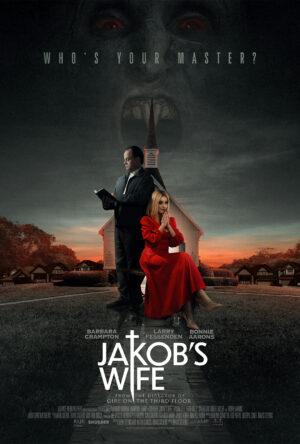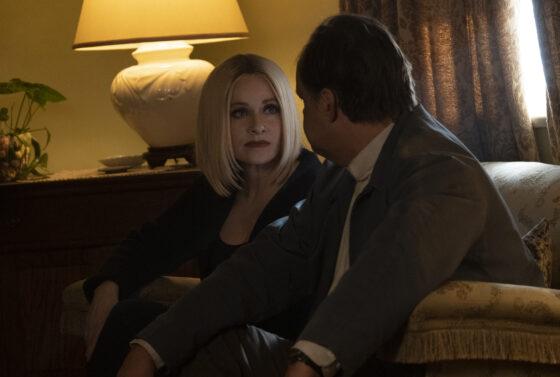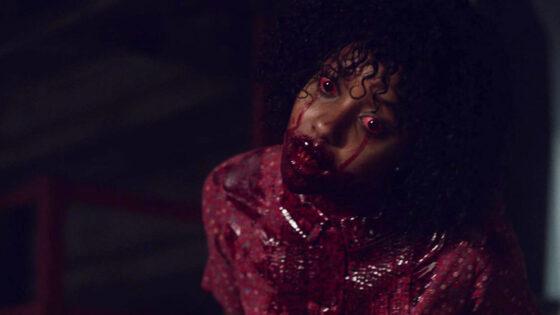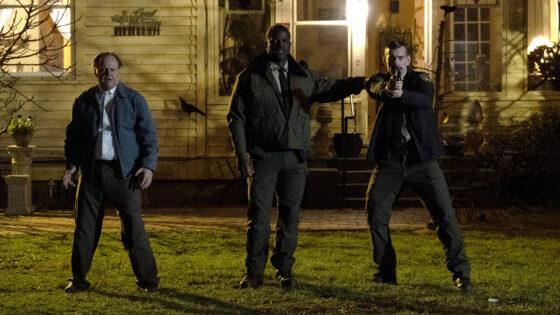

[Rating: Minor Rock Fist Up]
Out April 16 in select theaters, on demand, and digital HD.
Jakob’s Wife, writer/director Travis Stevens‘ follow-up to the stellar Girl on the Third Floor is a slyly comedic take on the vampire genre, with the added bonus of offering up a really powerful role for star Barbara Crampton. Co-written by Stevens alongside Mark Steensland (The Special) and Kathy Charles (Castle Freak), Jakob’s Wife takes quite a few cues from bloodsucker films which have preceded it, but the script is imbued with a strong sense of empowerment for the role of Crampton’s Anne.
“Anne is married to a small-town minister and feels like her life and marriage have been shrinking over the past 30 years. After a chance encounter with ‘The Master,’ she discovers a new sense of power and an appetite to live bigger and bolder than before. As Anne is increasingly torn between her enticing new existence and her life before, the body count grows and Jakob realizes he will have to fight for the wife he took for granted.”

There are several things which make Stevens’ latest worth watching. First, it’s very much worth noting that getting to see Barbara Crampton dance to an electroclash cover of Concrete Blonde’s “Bloodletting” wasn’t something I knew I needed until I saw it happen on screen. Secondly, the film is a treasure trove of Easter eggs for fans of genre cinema. “The Master” is 100% an homage to Barlow, the chief villain in Tobe Hooper’s Salem’s Lot, which is itself an homage to Max Schreck’s portrayal of Count Orloff in F.W. Murnau’s Nosferatu. The “vampire comes to a small town to take over without being noticed” is also a trope which has been explored in Salem’s Lot, to say nothing of Fright Night, et al.
Anne and Jakob (actually, Jacob, but same diff) are also the names of the respective characters played by Crampton and Larry Fessenden in writer/director Ted Geoghegan’s 2015 film, We Are Still Here, which was produced by Stevens and – not for nothing – is also a film about an older couple dealing with a marriage which has deteriorated with time.
However, whether one spots these Easter eggs or not should really have no bearing on whether or not a viewer finds Jakob’s Wife worth watching. They’re a nice bonus for horror fans, but Stevens’ film thankfully succeeds regardless of one’s depth of genre knowledge, because at its heart, the movie is a story about a woman who finds her own strength and voice in a relationship where she’s frequently been relegated to the passenger seat.
Seeing Anne go from meek to powerful is excellent, and while there’s but a few minutes’ glimpse into her and Jakob’s marriage before the transformation occurs, there’s a wealth of information conveyed in glances, facial expressions, and the minutiae of a longtime marriage. Each half of this couple has their expectations as to how things should be going, and only one of them has said expectations being met.

Watching Crampton and Fessenden’s interactions change over the course of the first half of Jakob’s Wife is arguably the biggest thrill in Stevens’ film. The pair of genre stalwarts rarely get a chance to shine in leading roles, and a film about grown-ups dealing with the results of the inevitable decline of their marriage paired with the thrills of vampirism’s instantaneous changes means that they really get a chance to shine whenever they’re on screen together.
Additionally, and much like Girl on the Third Floor, Stevens really leans into the sticky and goopy aspects of his subject matter. Things – mostly blood and viscera – spray, drip, squirt, and ooze, and are played equally for shock and humor. Watching this film is just as likely to make the viewer chuckle uncomfortably as to shriek, but there’s always a sense of discomforting wriggling in one’s seat. Part of that may also be due to the fact that there are a few scenes where Tara Busch‘s score overpowers. It’s a fine soundtrack to the movie, eerie and beautiful, but a couple of scenes have it so high in the mix, I thought it was diagetic, rather than score. It’s loud.

The downside to Jakob’s Wife is that, while Crampton and Fessenden shine in their roles and interpersonal interactions, the rest of the cast doesn’t make much of an impression. Perhaps it’s the fact that the leads have managed to snatch victory from the jaws of defeat with superb performances in some otherwise lackluster pictures over the course of their careers that they manage to make every scene together feel like it’s cinematic gold.

That said, a late-hour appearance by Phil “C.M. Punk” Brooks is a breath of fresh air, as he’s one of the few peripheral actors who manages to understand that while Jakob’s Wife isn’t quite a comedy, there’s definitely a sense of acknowledging the absurdity of everything which is taking place. Were that the rest of the cast was as on-the-ball as the trio of Crampton, Fessenden, and Brooks, but the movie still manages to be fun and entertaining despite that lack.





Comments on this entry are closed.